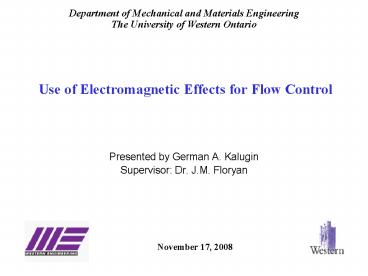Use of Electromagnetic Effects for Flow Control - PowerPoint PPT Presentation
1 / 24
Title:
Use of Electromagnetic Effects for Flow Control
Description:
When an electrically conducting fluid flows in the presence of magnetic field, ... Squire's like modes. Disturbance equations. Needed numerical solution. Always stable ... – PowerPoint PPT presentation
Number of Views:72
Avg rating:3.0/5.0
Title: Use of Electromagnetic Effects for Flow Control
1
Use of Electromagnetic Effects for Flow Control
Department of Mechanical and Materials
Engineering The University of Western Ontario
- Presented by German A. Kalugin
- Supervisor Dr. J.M. Floryan
November 17, 2008
2
Outline
- Introduction
- Objective
- Motivation
- Formulation of problem
- EM field configurations
- Particular case
- Current state
3
What is MHD ?
- When an electrically conducting fluid flows in
the presence of magnetic field, electric currents
are induced. These currents - produce the Lorentz force that modifies
- the motion of the fluid
- modify the magnetic field
MHD
Fluid Mechanics
Electrodynamics
4
Faradays experiment (1832)
Crowds attend the opening of Waterloo Bridge in
1817
5
Hartmann flow (1) Induced currents
y
x
z
u
Side wall
Müller, U. and Bühler, L. (2001)
Magnetohydrodynamics in Channels and Containers
6
Hartmann flow (2) Velocity profile
y
Hartmann flow
Poiseuille flow
x
7
Destabilizing effect of magnetic filed
http//web.mit.edu/html/ncfmf.html
8
Objective
- To develop strategies for flow control
- using EM effects
- To find an optimal spatial distribution
- of EM field leading to the formation
- of streamwise vortices
9
Why EM control
- Fast-acting
- Rapid on-demand deployment
- Absence of moving parts
- Remote control of industrial equipment
- Lower energy budgets
10
Why streamwise vortices
- Streamwise vortices significantly improve fluid
mixing and heat transfer - Some examples with EM effects
- cooling systems for fusion blankets
- liquid metals are used as a coolant
- continuous casting of steel
- EM stirring is used for homogenization process
11
Formulation of problem
We consider a steady-state parallel flow of
incompressible, viscous, electrically
conducting fluid with constant properties
between two parallel infinite plates in the
presence of externally imposed electrical and
magnetic fields.
y
y
x
x
z
12
Incompressible MHD equations
13
Scales EM group
- Defined in terms of the fluid properties
- density
- kinematic viscosity
- electrical conductivity
- magnetic permeability
Magnetic field
Electric field
Electric current density
14
Scales FD group
Dynamic effect (d)
EM effect (e)
Dimensionless form
where
15
Dimensionless parameters
Magnetic field number
(Hartmann number)
Electric field number
Magnetic Reynolds number
Magnetic Prandtl number
( Reynolds number
)
16
Characteristic values
Rudiger, G. Hollerbach, R. (2004) The
Magnetic Universe.
17
(No Transcript)
18
To formulation of problem
y
x
19
Particular case
- Externally imposed fields are oriented
- Electric field in the streamwise direction
- Magnetic field in the spanwise direction
y
y
x
x
z
20
Linear stability equations
Disturbance equations
Orr-Sommerfeld like modes
Squires like modes
Needed numerical solution
Always stable
21
Why spanwise magnetic field does not effect on
2D disturbances
y
traveling disturbances
L
K
Q2
R1
R2
Q1
N
S1
A
P2
P1
S2
Bz
x
z
Hunt, J.C.R. (1966) On the stability of parallel
flows with parallel magnetic fields, Proceedings
of the Royal Society of London. Series A,
Mathematical and Physical Sciences, Vol. 293,
No. 1434 , pp. 342-358
22
Numerical results
Contour lines for
Contour lines for kc
23
Stability mechanism
y
is balanced by
1
is balanced by
y
2
x
z
24
Acknowledgments
- Prof. J.M. Floryan
- Prof. K. Adamiak
- (Department of Electrical and Computer
Engineering) - PhD students Syed Zahid Husain
- Mohammad Zakir
Hossain































